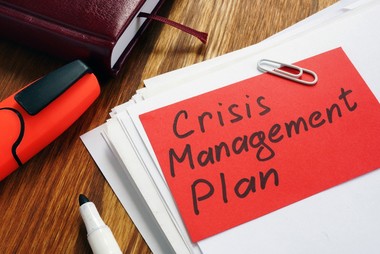Feb 15, 2024

Usually, serious crises pose threats and embody an element of some surprise stemming from unique or unanticipated events. Although the probability of occurrence may be rare, the resulting impact can be immense.
The art of crisis management involves managing, preparing for, limiting and mitigating damage. It calls for prompt and resolute actions driven by swift decisions that are often made on the fly. Customers or key employees could flee in droves, operations could be disrupted and assets such as factories and offices could be affected. Managing and not managing a crisis correctly could impact an organization, people's livelihoods and even the physical safety of employees. At all costs, you want to prevent a catastrophe, which is the result of a badly handled crisis.
So much can go wrong
While each unique crisis ultimately requires its own solution, major corporate threats tend to fall into certain categories, such as:
Globalization amplifies the consequences of local flare-ups with a domino effect. At the same time, modern technology, such as social media, increases the rapid spread of rumors and negative information. Consequently, the window for damage control has narrowed.
Proper prior planning prevents poor performance
Those six words sum up the best defense against the unknown and unknowable. The general goal of crisis management is to return the business to normal as soon as possible and with the fewest possible repercussions. Having a plan is central to achieving that. However, since every crisis is unique, it is futile to try to construct systematic step-by-step plans to fit every contingency. The only practical solution is to learn and evolve midstream, if necessary, and be ready to adapt tactics to fit the current problem.
Ian Mitroff, an organizational theorist, has developed a highly regarded five-stage model for managing crises:
Large organizations sometimes employ a dedicated crisis manager. In smaller settings, the HR department may serve as a channel for consistent internal communication and feedback. A crisis team typically comprises the head of each department, the company lawyer and an HR representative. And a team member can coordinate sub-teams.
Some golden rules
Panic is never the answer. A crisis sometimes brings out the best in leadership. That is when character is ultimately tested in the workplace. You should assume your colleagues are also feeling the heat. They will draw on your example if you can keep a cool head.
Above all, be honest and keep the lines of communication flowing to all stakeholders. Do not make excuses. Holding yourself accountable is a sign of a true leader. It may be tempting to downplay the gravity, but do not pretend you hold a nonexistent solution or make unrealistic promises you cannot fulfil. If there is a risk of redundancies to come, it may be fair to warn employees.
Try to stay organized. Keep providing updates, even if nothing has really changed. You could trigger mass anxiety if you suddenly clam up, as co-workers will suspect the worst. Regular meetings can help boost morale.
©2024